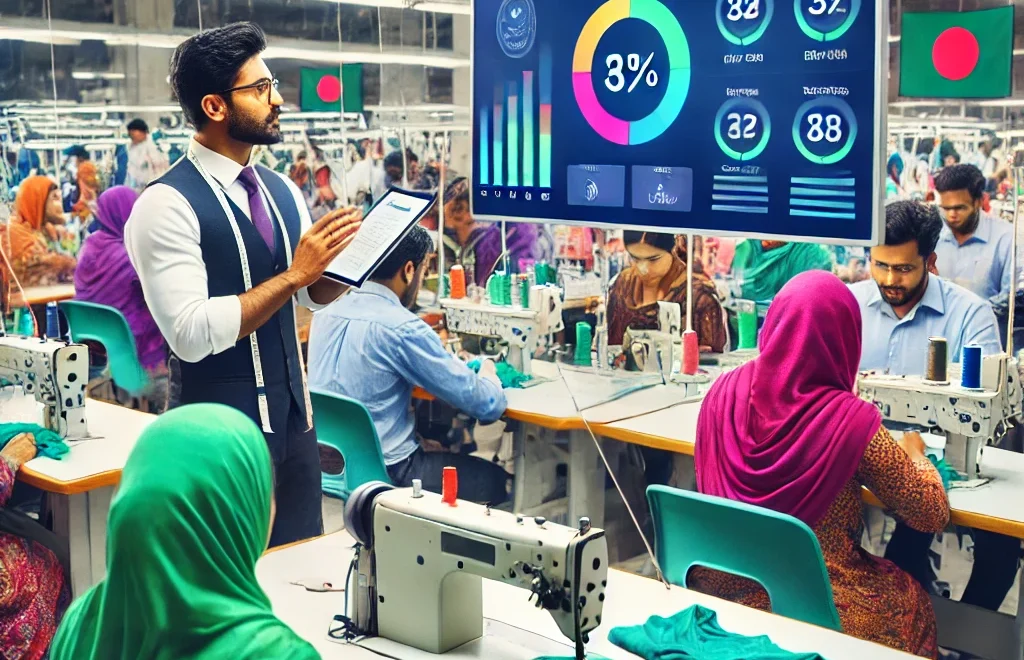Introduction: Overcoming Low-Performance Challenges in the Bangladesh RMG Sector
The Ready-Made Garment (RMG) industry in Bangladesh is a cornerstone of the nation’s economy, contributing significantly to GDP and employment. As global demand for high-quality apparel increases, so does the need for a skilled workforce. However, many factories struggle with low performance due to inadequate training, lack of motivation, and outdated skill sets. Addressing these issues through effective training models is critical for sustainable growth and improved productivity.
The Growing Demand for a Skilled Workforce in Bangladesh’s RMG Industry
With Bangladesh being one of the world’s largest exporters of garments, international buyers expect high standards in both productivity and quality. As the industry expands, factories must ensure their workers have the necessary skills to meet global market demands. Failure to do so not only affect factory output but also impacts the country’s competitiveness in the apparel sector.
Why Tackling Low-Performance is Key to Sustainable Growth and Performance Gaps
Low performance in RMG factories results in missed deadlines, increased production costs, and high rejection rates. Training programs specifically designed to upskill workers can mitigate these challenges. A well-trained workforce can contribute to better efficiency, reduced defects, and overall business growth.
Training is not just a one-time solution but a continuous process that equips workers with relevant skills. It helps bridge the gap between the industry’s evolving needs and the workforce’s capabilities. By integrating modern training methodologies, RMG factories can improve performance, worker engagement, and overall efficiency.
Understanding the Key Challenges in the RMG Workforce
Many workers enter the RMG sector with minimal training or prior experience, resulting in a steep learning curve. Common skill gaps include:
- Poor understanding of quality standards
- Inefficiencies in machine handling
- Lack of time management skills
- Weak communication and teamwork abilities
Low-Performance Causes: From Inadequate Training to Lack of Motivation
Factors contributing to low performance include:
- Inadequate training: Many workers rely on informal learning, which limits their ability to handle complex tasks.
- Limited incentives: Without proper motivation, workers often remain disengaged.
Workplace conditions: Poor working environments lead to high absenteeism and turnover rates.

Akhi Akter – Managing Editor
(Textile Today)
“Technologies have an important role to improve the global textile and apparel manufacturing processes and procedures.”
Continuous Upskilling and Effective Training in the Evolving Apparel Market
The apparel industry is evolving with new machinery, automation, and design innovations. To keep up, workers must receive ongoing training in these areas. Continuous learning not only improves efficiency but also enhances job satisfaction and career progression.
Traditional training methods focus on classroom-based learning, which is often theoretical and lacks practical exposure. Modern training models, such as blended learning and on-the-job training, provide more effective results by incorporating hands-on experience and technology-driven approaches.
Blended Learning: Combining Classroom Education with Practical Application
Blended learning integrates classroom instruction with real-world practice, ensuring workers understand both theoretical concepts and practical applications. This model helps in:
- Improving knowledge retention
- Enhancing hands-on skill development
- Increasing worker confidence in real-life factory scenarios
On-the-Job Training: How Real-World Experience Drives Performance
On-the-job training (OJT) is one of the most effective ways to enhance worker performance. By allowing employees to learn while working, they gain firsthand experience, making them more proficient in their roles. OJT is particularly beneficial in:
- Reducing onboarding time for new employees
- Enhancing adaptability to real factory conditions
- Improving teamwork and communication skills
The Role of E-Learning and Technology in Modern Training Programs
Technology plays a crucial role in modern training programs. E-learning modules allow workers to access training materials remotely, making it easier for them to learn at their own pace. Digital tools, such as interactive videos and simulation-based training, have proven to be effective in skill enhancement.
A leading RMG factory in Dhaka implemented a structured training program focusing on sewing efficiency and quality control. The results:
- A 30% increase in productivity
- A 20% reduction in defect rates
- Improved worker morale and retention
How Leading RMG Factories Have Boosted Output Through Innovative Training
Factories investing in structured training programs have reported significant improvements in efficiency. Programs focusing on soft skills, machine handling, and quality control have resulted in fewer defects and better production timelines.
A major apparel manufacturer introduced an employee-centric training program emphasizing attention to detail and precision. This initiative led to:
- A 25% increase in first-time quality pass rates
- Reduced rework and material wastage
- Higher customer satisfaction scores
Lessons Learned from Successful Programs: What Worked, What Didn’t
Key takeaways from successful training programs:
- Practical, hands-on training is more effective than purely theoretical learning.
- Employee engagement and motivation significantly impact performance.
- Regular feedback and assessment are essential for continuous improvement.
Measuring Success: How to Quantify the Impact of Training on Performance
Measuring training success requires clear KPIs such as:
Productivity improvements (output per worker), Reduction in defects and rework, Employee engagement and retention rates, data-driven assessments help track progress and identify areas needing improvement. Regular evaluations ensure training remains aligned with industry demands. Encouraging worker feedback and continuously updating training programs ensure sustained performance improvements.
Groyyo’s Role in Transforming Bangladesh’s RMG Workforce
Groyyo, a technology-driven platform, is actively bridging skill gaps in RMG factories through innovative training solutions.
Groyyo collaborates with factories to provide customized training programs that address specific skill deficiencies.
By leveraging AI-driven training modules and digital assessments, Groyyo enhances worker efficiency and factory productivity.
Driving Results with Groyyo’s Training Initiatives
Factories using Groyyo’s training solutions have seen:
- A 40% improvement in efficiency
- Enhanced worker engagement and satisfaction
Enhancing Worker Retention and Satisfaction Through Tailored Training Programs
Groyyo’s personalized training modules have contributed to higher employee retention and a more motivated workforce. Investing in scalable training models ensures that more workers can be upskilled efficiently. AI-powered training tools streamline learning processes, making training more accessible and effective. A long-term approach to workforce development ensures continued growth and industry competitiveness.
Conclusion: A Roadmap to Overcoming Low-Performance Challenges
To stay competitive, Bangladesh’s RMG sector must tackle low performance through structured training, including blended learning and e-learning. Tech-driven solutions like AI training and real-time feedback boost efficiency. Groyyo’s tailored programs bridge skill gaps and enhance worker engagement. A sustainable upskilling ecosystem ensures long-term growth, solidifying Bangladesh’s global apparel leadership.

Divya Mohan
General Manager (International Business)
divyamohan@groyyo.com


Leave a Comment